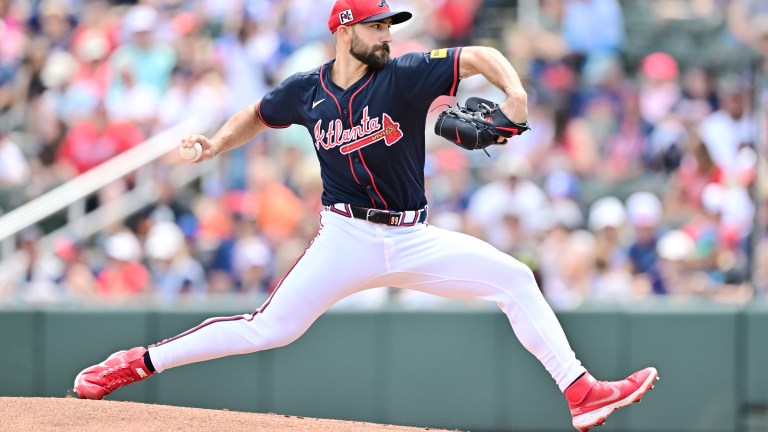Spencer Strider Won’t Save the Braves Himself, But He Will Help
In the midst of a slow start, the Atlanta Braves hope the return of Spencer Strider can help turn things around.

The Atlanta Braves are off to a disastrous 5-11 start to the season, something nobody could’ve predicted. The offense isn’t clicking, the bullpen has been a roller coaster, and the starting rotation has been subpar at best.
The good news? Reinforcements are on the way. Spencer Strider is set to make his season debut on Wednesday, his first big league start in 376 days after undergoing season-ending elbow surgery last year. The Braves took the cautious route, giving Strider the time he needed to rehab properly to make sure he is 100% upon return.
Spencer Strider was cleared to participate in Spring Training and immediately reminded fans why he’s one of the best pitchers in baseball.
In just two appearances, Strider gave up only two hits, two earned runs, and one walk while striking out 10 batters across four innings. It was a small sample, but enough to get Braves fans fired up. The Cy Young candidate looked sharp and, more importantly, healthy.
Strider was assigned to the Gwinnett Stripers, the Triple-A affiliate of the Atlanta Braves, as he continued to rehab and get ready for his return. It only took him three outings to prove he is ready.
Minor Leaguers Were No Match for Strider
Spencer Strider made three starts in Triple-A on his rehab assignment and did nothing but carve up the opposition in a way you might expect from a guy who has a career 13.5 K/9.
vs. Charlotte Knights: 3 IP, 2 H, 1 ER, 1 HBP, 1 BB, 6 K
vs. Nashville Sounds: 5.1 IP, 0 H, 0 ER, 2 BB, 8 K
vs. Norfolk Tides: 5.1 IP, 3 H, 1 ER, 2 BB, 12 K
Across those outings, Strider posted a 17.8 K/9, 52.9% strikeout rate, a 0.94 WHIP, and limited opponents to just a .111 batting average. In fact, at the time of writing, he leads the International League in strikeouts with 27.
Coming off a major elbow injury, it is fair to question how quickly Strider will be able to return to form. Diving into these three rehab stints, I feel confident that we will see 2023 Strider quicker than one may expect.
| 4-Seam | Pitches | K% | Whiff% | xwOBA | Velo (MPH) | Spin (RPM) | EXT (ft) |
| 2023 | 1826 | 28.5% | 28.7% | .317 | 97.2 | 2362 | 7.0 |
| 2025 | 124 | 38.9% | 32.3% | .283 | 95.7 | 2253 | 6.9 |
| Change | Pitches | K% | Whiff% | xwOBA | Velo (MPH) | Spin (RPM) | EXT (ft) |
| 2023 | 225 | 33.3% | 44.4% | .197 | 87.0 | 2257 | 7.1 |
| 2025 | 24 | 71.4% | 75.0% | .099 | 86.1 | 1877 | 6.9 |
| Slider | Pitches | K% | Whiff% | xwOBA | Velo (MPH) | Spin (RPM) | EXT (ft) |
| 2023 | 1048 | 50.9% | 55.3% | .217 | 85.6 | 2345 | 7.0 |
| 2025 | 64 | 58.3% | 62.2% | .161 | 84.4 | 2282 | 6.8 |
| Curve | Pitches | K% | Whiff% | xwOBA | Velo (MPH) | Spin (RPM) | EXT (ft) |
| 2024* | 21 | 66.7% | 60.0% | .146 | 79.6 | 2589 | 6.9 |
| 2025 | 12 | 50.0% | 40.0% | .041 | 79.2 | 2589 | 6.8 |
Now, let’s be clear, a three-game sample size is usually too small to draw conclusions. Right now, it’s all we’ve got, and what Strider has shown so far is very encouraging.
The primary area of focus is, of course, his elite fastball. On paper, a 1.5 mph dip in average velocity might raise slight concerns, but considering he’s still building back arm strength it’s reasonable to expect that velocity to climb.
What really matters with Strider’s fastball is the spin rate. Even with a slight 109 rpm drop, he’s still spinning it close to that elite 2300 rpm marker. He is generating whiffs and setting the table for his secondary pitches.
A key to Strider’s success is how well he can play his secondary pitches off the elite fastball. So far, the whiff rates on both his change-up and slider have improved, and he’s posted strikeout rates at or above 50% across all three of his secondary pitches.
Now yes, a player of Spencer Strider’s caliber should be expected to dominate in the Minor Leagues. But it’s one thing to expect dominance and another to actually go out and execute. Strider hasn’t just met expectations, he’s exceeded them, and now gets to head back to the big leagues.
How Much Does This Life the Braves?
This could be the exact jolt the Braves need. While Strider won’t fix an offense that ranks bottom 12 in runs, RBIs, batting average, and OPS, his presence atop the rotation brings much-needed stability and confidence to a team that’s been desperately searching for it.
Spencer Schwellenbach has been one of the best pitchers in baseball to start the season, but outside of him, the Braves’ rotation has been overwhelmingly average.
Chris Sale, last year’s NL Cy Young winner, has stumbled out of the gate with a 6.63 ERA, a 1.53 WHIP, and at least 3 earned runs allowed in every start. Grant Holmes has battled command issues, allowing 10 walks, though to his credit, he’s minimized damage and improved with each start since his outing in San Diego.
A.J. Smith-Shawver and Bryce Elder have had their own struggles as well, but the return of Strider will allow the Braves to use multiple arms in the fifth spot of the rotation until one emerges to claim that spot.
Spencer Strider alone won’t fix all of Atlanta’s early-season issues. But if he returns to form, the Braves would immediately have their front-line ace back and suddenly the starting rotation looks significantly better.
Most teams look to make in-season additions to boost their current roster. The Atlanta Braves have the fortunate opportunity to get back not one, but two internal additions to their roster that happen to each be considered one of the best at their positions in Ronald Acuña Jr and Spencer Strider.
The start of the season has been rough for Braves fans, but reinforcements are on the way and better times are ahead. Not many teams could bounce back after a start like this, but luckily the Braves are one of those teams that can.
